Module 6
1. Module 6
1.19. Page 4
Module 6: Triangles and Other Polygons
Bringing Ideas Together
In the Explore section you investigated a practical problem involving similar right triangles. Remember, two right triangles are similar if there is a pair of congruent, corresponding acute angles.

ΔABC is similar to ΔDEF since ∠C is congruent to ∠F.
Of course, not all similar triangles are right triangles. In the previous lesson, you explored the following requirements, or conditions, for stating that any pair of triangles are similar:
-
The corresponding angles are congruent.
-
The corresponding sides are proportional.
-
One pair of angles is congruent and the two pairs of corresponding sides that form those angles are proportional.
The following examples and Self-Check questions involve identifying similar triangles in problem-solving contexts, and then applying proportional reasoning to solve these problems.
Example 1
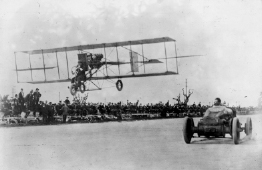
Topical Press Agency/Hulton Archive/Getty Images

Petranella is building a scale model of a 1910 Curtiss biplane. She is working on the tail section and has taken measurements from an online graphic, but she forgot to measure x. What is the measure of x correct to one decimal place?

Solution
Separate the triangles. Are the triangles similar?
The two triangles share an angle at the tail section.
The ratios of the sides forming the shared angle are equal, ![]()
As a pair of angles is congruent and the two pairs of corresponding sides that form those angles are proportional, the triangles are similar.
Set up a proportion.
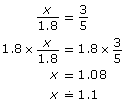
The missing measure is approximately 1.1 cm.
Example 2
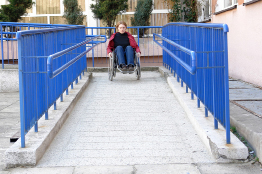
© prism68/shutterstock
A wheelchair ramp is 5 m in length. The bottom of the ramp is 0.6 m below the top of the ramp. When a wheelchair is moved 2 m down the ramp, how far is the wheelchair above the foot of the ramp?

Solution
Separate the triangles.
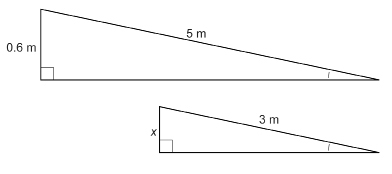
Are the triangles similar?
Observe that the two right triangles share an acute angle. So, you can apply Condition 4 for congruence of right triangles.
You may remember Condition 4 from the following diagram.

Condition 4: For right triangles, if one pair of acute angles is equal in measure, the triangles are similar.
In the separated triangles describing the ramp, the marked angles are acute and congruent. So, Condition 4 is met. Therefore, these right triangles are similar, and the ratios of the corresponding sides of these right triangles are proportional.
Set up a proportion.

The wheelchair is 0.36 m above the foot of the ramp.
 Self-Check
Self-Check
SC 4. Jon walked 10 m away from a wall outside of his school. At that point, he noticed that his shadow reached the same point on the ground as the school’s shadow. If Jon is 1.6 m tall and his shadow is 2 m long, how high is the school? Round to one decimal place.
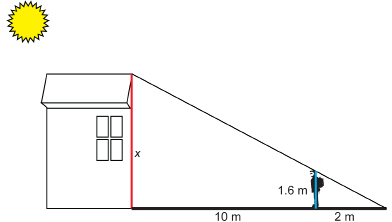
SC 5. Dace is standing on the shore of the North Saskatchewan River. She sees a fisherman, F, on the opposite bank.
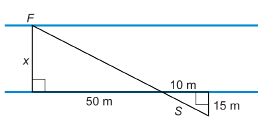
She would like to know how wide the river is at this point. Dace walks 50 m downstream along the riverbank. She stops and pushes a stick, S, into the bank. Dace walks another 10 m downstream, and then turns 90°. She now walks 15 m away from the river until she sees that the stick she pushed into the bank lines up with the fisherman across the river. Calculate the width, x, of the river.
SC 6. A chalet in the mountains has a triangular profile.

There is a balcony 9 ft above the ground. If the chalet is 25 ft across the base and 20 ft high, what is the width of the balcony?
SC 7. The crossed legs of an ironing board are illustrated.
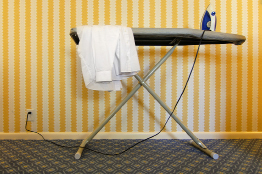
© Lane V. Erickson/shutterstock
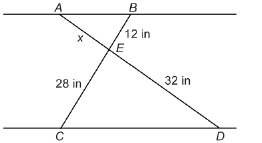
-
If the top of the ironing board is parallel to the floor, is ΔABE similar to ΔDCE? Justify your answer.
-
Determine the value of x to the nearest tenth of an inch.
SC 8. A 2-m pry bar is placed under a timber 20 cm from the end of the bar. The free end of the bar is lifted 30 cm. How high off the ground is the timber?

 Mastering Concepts
Mastering Concepts
Try this question. When you are finished, check your answer.
![]()
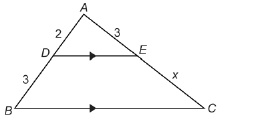
-
Why are
 similar?
similar?
-
Determine the value of x.